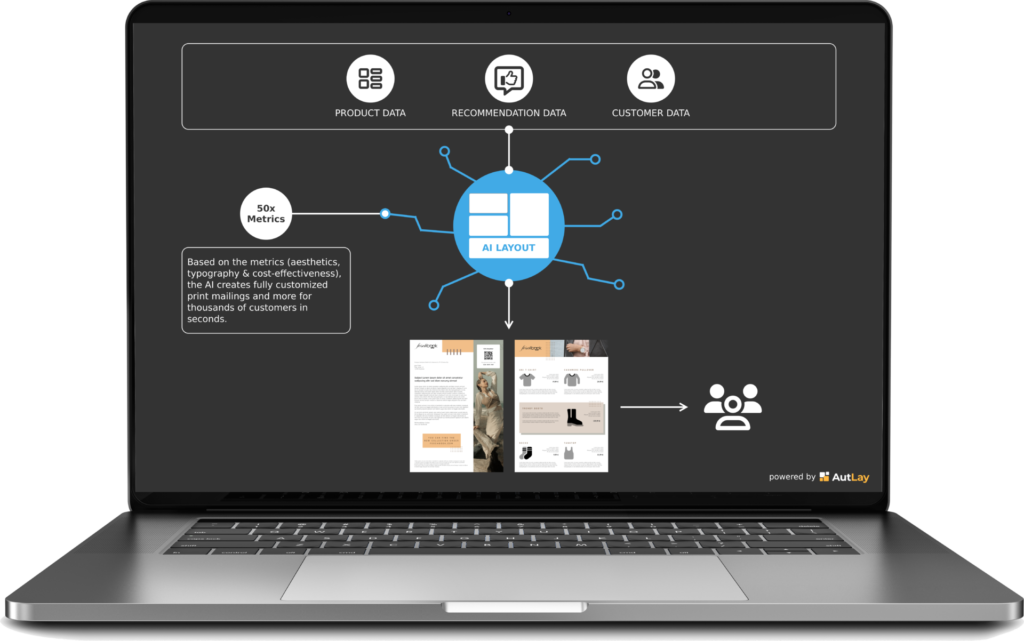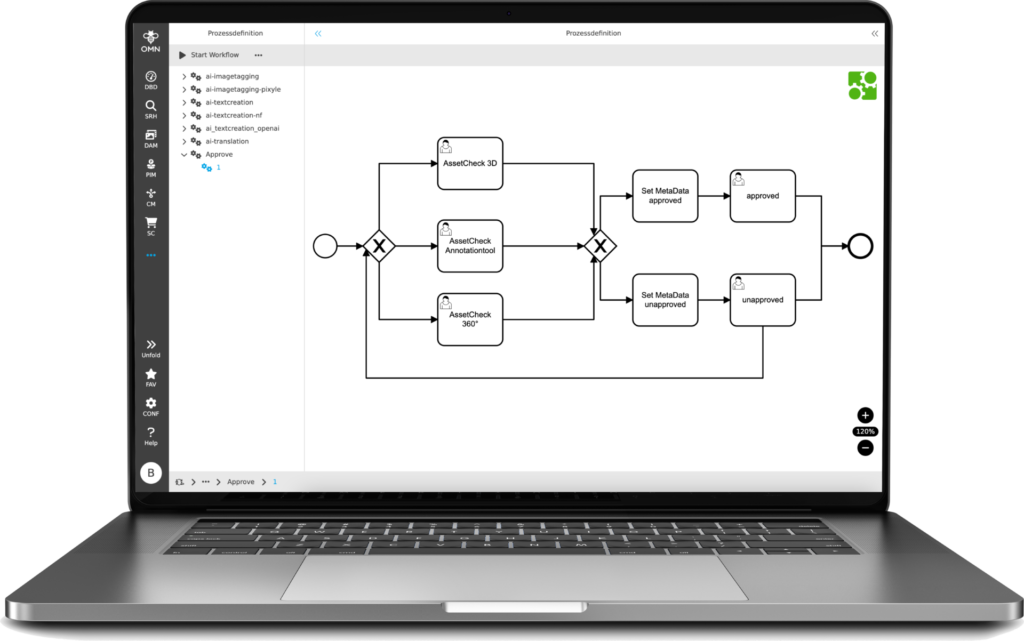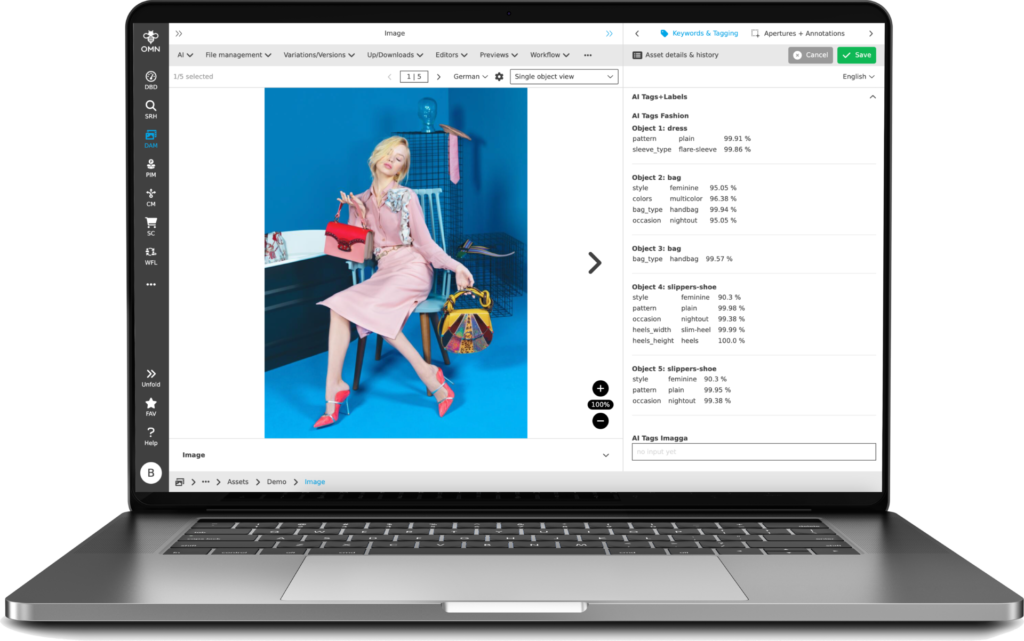Revolutionise your DAM with AI!
Digital Asset Management
The rise of AI is far more than just a passing trend. AI has already proven to be indispensable and extremely relevant for companies. According to the Deloitte study State of AI in the Enterprise, 94% of managers believe that AI will be crucial to success in the next five years. In addition, 75% of CEOs believe that competitive advantage will depend on who has the most advanced generative AI. In addition, PwC’s Global Artificial Intelligence Study predicts that AI could add a further 15.7 trillion dollars to the global economy by 2030. There are now also various practical applications of AI in the field of Digital Asset Management (DAM). In the following article, we will show you how AI in DAM systems enables you to handle complex tasks that normally require human intelligence.
Excursus: Difference between AI and Automation
Before we delve deeper into the topic, we should differentiate between AI and automation. Both technologies make human labour easier, but differ in the way they work and are used. While automation maximises efficiency for repeatable tasks, AI enables intelligent adjustments and complex decisions. For example, an automated system could assemble the same component over and over again, while an AI system would recognise defects in these components and constantly improve. Nevertheless, both technologies complement each other and contribute to the optimisation of business processes.

Areas of application for AI in DAM systems
Artificial Intelligence can be implemented in various areas of a DAM system to automate processes, increase efficiency and improve the quality of the assets managed. A distinction is made between content management and content creation. Here are some concrete examples of how AI is used in DAM systems.
1. Content Management
Managing content can be time-consuming and block resources that could be used for really important tasks. AI can help you to completely take over repetitive, non-value-adding tasks and thus considerably simplify your content management.
Automated keywording (tagging) and categorisation
A common problem in the management of digital assets is the time-consuming and manual tagging and categorisation. AI-supported DAM systems can automate these tasks by using algorithms for image recognition and natural language processing (NLP).
Example: A company that manages a large number of product photos can use an AI-supported DAM system to automatically assign relevant tags such as ‘blue shirt’, ‘summer collection’ or ‘sportswear’. This makes it much easier to find and organise the photos.


Automatic image cancellation
Image cropping, also known as ‘background removal’, is an important process in image editing in which the background of an image is removed to emphasise the main subject. Traditionally, this was a time-consuming manual process that required precision and patience. However, the introduction of AI has considerably simplified and accelerated this process.
Example: An online fashion retailer wants to optimise its product photos for the web shop. Instead of manually cropping each image, the company uses an AI service to crop images. A new item of clothing is photographed and the image uploaded to the DAM system. The integrated AI immediately recognises the garment and removes the background, leaving only the garment in front of a transparent background. This process only takes a few seconds per image. The cropped image can now be easily used in various marketing materials, be it on the website, in social media or in print catalogues.
Face recognition and person identification
For companies that regularly manage image material from events or photo shoots, identifying people can be a tedious task. AI-supported facial recognition can automatically recognise and identify people in images.
Example: An event management company uses a DAM system with integrated facial recognition to automatically identify and organise all photos of a particular speaker or guest during an event.


Intelligent search
Searching for specific digital assets in large databases can be a challenge. AI can improve the search function by understanding context-based search queries and delivering relevant results.
Example: A marketing team is looking for a picture of a ‘smiling person in the park’. An AI-supported DAM system can understand this request and display suitable images from the database instead of relying on simple keyword searches.
Automatic paths
If e-commerce retailers do not want to use a white background in their product photos, this is often a challenge. In such cases, the photos need paths or alpha channels around the object and creating these requires a lot of manual work, even if programmes such as Photoshop make the process easier. But here, too, AI provides support.
Example: An online furniture retailer wants to present its products in different room settings. Instead of manually cropping each product image and creating paths, the retailer uses a DAM system with integrated AI. The AI automatically recognises the contours of the furniture, creates exact cut-outs and saves the corresponding paths in the system. This enables the retailer to quickly and easily place the cut-out pieces of furniture in front of different backgrounds and thus create appealing and varied product presentations.


Channel-specific resizing for various marketplaces
The requirements for image sizes and formats vary greatly between different online marketplaces. AI-supported resizing in DAM systems can automate this process and ensure that images are optimally adapted for each marketplace.
Example: An e-commerce company uses a DAM system with integrated AI to automatically customise product images for various marketplaces such as Amazon, eBay and Etsy. As soon as a new product image is uploaded, the AI generates versions of the image in the required sizes and formats according to the specific requirements of each marketplace. This automated customisation ensures that all product images comply with the guidelines of the various platforms without the need for manual adjustments. This not only saves resources, but also ensures a professional presentation of the products on all marketplaces and helps to maximise the attractiveness of the products.
2. Content Creation
AI can help speed up various content-related tasks, ensuring more efficient and effective content creation and optimisation.

Automated creation of meta information
AI plays a decisive role in the generation of meta titles, meta descriptions and keywords for digital content. By providing information about a product, the DAM system can immediately create relevant meta titles and descriptions. This automation not only saves time and ensures consistent, SEO-optimised metadata, but also ensures that all possible keywords are covered in the name and that products can also be found via image search, for example.
Example: An online store for electronic devices uses an AI-supported DAM system. When a new smartphone is added, the AI can automatically add a meta title such as ‘Innovative smartphone with advanced camera – buy now’ and generate a meta description such as ‘Discover the latest smartphone with a high-resolution camera, long battery life and modern design. Perfect for tech lovers and frequent users. Now available in the shop.‘ This automatically generated metadata is not only consistent and optimised, but also immediately ready for use, which significantly speeds up the workflow.
Automated translations of documents
Managing multilingual content is a challenge for globally active companies. AI-supported translation services can extend DAM systems to automatically translate documents such as Word, PowerPoint, Excel or PDF into different languages.
Example: An international company uses a DAM system with AI translation services to automatically translate meta information and marketing materials (Word, PDF, Excel, etc.) into multiple languages, which shortens time to market as content is translated in real time.


Automated creation of product texts based on image information
For companies that offer a wide range of products, creating customised and appealing product texts is a time-consuming task. AI-supported text generation can enhance DAM systems so that product descriptions are created automatically based on the image information.
Example: An e-commerce company uses AI to automatically generate product texts. As soon as new products are added to the DAM system, the AI analyses the image content and uses it to create appealing and informative descriptions. This AI text generation not only saves time and resources, but also ensures consistent and high-quality content that improves the customer’s shopping experience. At the same time, the company can bring its products to market faster and ensure that the descriptions are always up-to-date and relevant.
Personalised advertising material based on user data
By using AI, content can be personalised by analysing user data. This makes it possible to tailor content to specific target groups and deliver more relevant and appealing content.
Example: An online retailer uses a DAM system with integrated AI to analyse user data such as purchasing behaviour, browsing history and preferences. The AI then creates personalised product recommendations and tailored marketing content for each individual customer. In this way, a customer who frequently searches for sportswear receives targeted offers and news from this area. The AI generates the layout of the corresponding advertising material, from the catalogue for the sale of stock to the mailing for shopping basket abandoners, without templates.


Automated image editing workflows
Workflows in DAM systems are nothing new. However, AI functions can be added to the workflows in order to transfer image editing or retouching processes such as skin editing, anti-aliasing, masking, face cropping, adding shadows or back mirrors to the AI.
Example: A fashion company uses a DAM system with integrated AI to optimise the image editing process. As soon as new photos from a photo shoot are uploaded, the AI automatically analyses the images and carries out various editing steps. The AI retouches skin blemishes on the models, applies anti-aliasing to smooth edges, masks the images for further processing, precisely cuts out faces and adds realistic shadows.
AI-assisted image generation with DALL-E
By using AI, images can be generated automatically by analysing text descriptions and converting them into visual representations. This makes it possible to create customised and relevant images that are precisely tailored to the needs and wishes of users.
Example: A designer uses DALL-E, an AI model for image generation from OpenAI, in his DAM system to create unique and personalised illustrations for his customers. By entering detailed text descriptions such as ‘a futuristic cityscape at night with flying cars and neon-coloured lights’, DALL-E creates impressive images that depict exactly these scenarios. This allows the designer to respond to specific customer requests and provide them with customised visual content without having to rely on standard templates.

Final thoughts: DAM systems and AI
Artificial Intelligence has fundamentally changed Digital Asset Management (DAM) and there is no end in sight – both in content management and content creation. Today, AI-supported DAM systems can completely take over routine tasks such as tagging images and creating meta information and advertising material. This helps you to manage your digital resources more efficiently, unleash your creativity and further strengthen your competitive advantage. The implementation of AI in DAM systems is therefore no longer a passing trend. Now is the time to use the changing landscape of content management to your advantage.
If you are planning to introduce a DAM system in the near future, then do so with AI functions. If you can’t imagine this so well, then take a look at our OMN DAM and let us introduce you to the AI functions in an online presentation – free of charge and without any obligation: Request a demo

Would you like to get to know our OMN DAM?
EXPERIENCE OUR OMN DAM LIVE AND SEE ITS PERFORMANCE FOR YOURSELF!